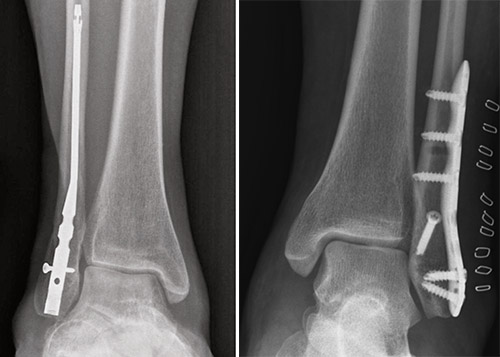

Over the last few weeks, the weather here in the tristate area has brought upon us what we tend to call “ankle fracture season.” This is very self explanatory: Those slippery sidewalks and streets tend to cause many of us to slip and fall. Thus, broken bones around the ankle are a common sequela of this type of injury.
Surgery to fix a broken ankle is an experience that can create a lot of distress and uncertainty. Must I have surgery? Can the broken bone heal on its own? Even when everything goes well, there are certain aspects of the recovery that can be a cause for concern. If surgery will yield the best outcome, how large will the incision be and will it heal properly? Will the metal plates and screws be felt under the skin? How long until I can walk normally?
Here at CMD, we treat every fracture and every patient with a specific patient-centric approach. The correct plan for one patient might not be the same for another, even if the fracture is similar in nature. If a patient’s broken bone will heal properly and timely without surgery, then that is fantastic! However, there are times when surgery is required to restore proper bone and joint alignment, as well offer stability and an earlier return to normal walking.
Traditionally, ankle-fracture surgery requires a long incision over the outside and possibly inside of the leg to expose the fracture site and restore proper bone position and alignment. Plates and screws are needed to hold the bones in place, but these can be felt underneath the skin.
However, newer techniques have been developed and are used here at CMD that allow for a small incision, and metal hardware that you cannot feel under the skin. It also adds adequate stability to the fracture that provides for safe return to normal walking, perhaps earlier than normal. By using a rod placed inside the bone through a small incision at the tip of the ankle, large incisions and prolonged recovery times are avoided.
Currently, this technique can only be used in fracture patterns that fit certain criteria. As technology advances it is likely that different types of ankle fractures can be treated this way. At CMD we are proud to continue to offer these cutting-edge, minimally invasive techniques and are privileged to help you get back on your feet as quickly as possible.
Please be careful walking in all this snow and ice. If you injured your ankle, please seek medical care quickly as this often yields the best outcomes. Here at CMD, we offer on-site x-rays, and a timely appointment with one of our foot and ankle specialists is always available.
Dr Popowitz is a double board-certified podiatrist/foot and ankle surgeon. He is chief of the foot and ankle division at the Center of Musculoskeletal Disorders in Englewood, New Jersey and Queens, New York. For appointments and consultations, please call 201-510-3777.










